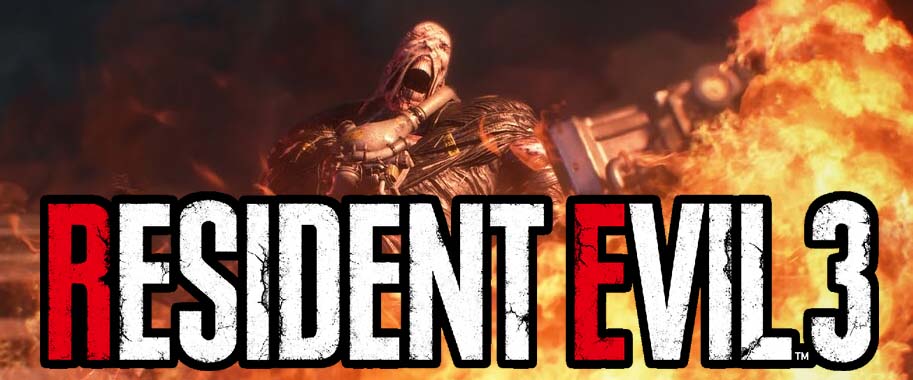
I played the demo of Nemesis that came packaged
with Dino Crisis, but never played the full game.
Right off the bat, I have to say that Resident Evil 3: Nemesis was never my favorite Resident Evil game. In fact, I never even played the whole thing. I played the demo that was included with Dino Crisis (back in the day when game publishers released playable demos before a game even came out). The original Nemesis erred more on the side of fast-paced action, which just doesn't appeal to me as much as the slower, more thoughtful design philosophy of the original Resident Evil, along with Silent Hill and Dino Crisis. This is why I love the original RE and its GameCube remake, why Resident Evil 4 rubbed me the wrong way, and why I never really got into the rest of the Resident Evil franchise beyond the first game. I tried playing all of the Resident Evil games up through 5, but the only one that came close to holding a candle to the masterful original was 2.
So even though I was excited to play Capcom's remake of the PS1 classic, I went in with tempered expectations. If they stayed true to the original, then RE3make (or whatever we're calling it) would be far more high-octane and action-heavy than the Resident Evil 2 remake that was released a mere year ago. As such, I expected that I just wouldn't be quite as into RE3make as I was into Resident Evil 7 or RE2make. I could only hope that it hit some happy medium between RE2make and Resident Evil 4. But that's really just personal preference on my part. Your tastes may vary.
So now that you hopefully understand where I'm coming from, what do I actually think of Resident Evil 3: Nemesis in 2020? Did Capcom learn any lessons from the few mistakes that were made with RE2make?
Resident Evil 3 is more reliant on spectacle action set pieces than on slowly building atmospheric tension.
The different nature of "Hardcore" mode
If you remember my review of Resident Evil 2 remake (and my lengthy YouTube critique), then you know that one of my core issues with that game was the fact that Capcom locked the Ink Ribbon save system behind that game's hard difficulty. Resident Evil 7 actually had the same problem, but it didn't bother me in that game because RE7 wasn't a remake of a game that included Ink Ribbon saves as a core component of its design.
I felt the Hardcore mode and breakable knife were huge design flaws in RE2make.
In summary, the hard mode made death come much swifter in RE2make. Resource-management wasn't as important as skillful aiming and shooting. Instead of taking a bite or two here and there and having to decide when to fill your scant inventory with a healing item just in case (in the original Resident Evil games), RE2make's hardcore mode made you have to heal pretty much every time you took damage because you couldn't survive a second hit. This low tolerance for mistakes and strict punishment for death felt considerably less fair for someone in a first-time playthrough.
The fact that your knife could break and you could literally be stuck with a save file in which you have zero damage-dealing potential certainly didn't help the feeling of fairness in my book.
My recommendation was for Capcom to separate the hard difficulty setting and the hardcore save system into two options. You should be able to chose whether you want to use Ink Ribbons, and then you should also be able to chose whether you want to play the game on easy, normal, or hard difficulties.
Typewriters are still here, but Ink Ribbons are completely absent.
Instead, Capcom opted to just remove Ink Ribbons for its Nemesis remake. Entirely. They are not locked behind hardcore mode. They are not locked behind New Game Plus. Typewriters are still here, but Ink Ribbons are not in the game at all.
... [More]
106af6d6-125a-4641-8a21-bad7e6976528|1|5.0
Tags:Resident Evil, Resident Evil 3: Nemesis, Capcom, Jill Valentine, Carlos Oliveira, nemesis, horror, survival horror, action, ink ribbon, zombie, knife, loot box, micro-transaction, pay-to-win
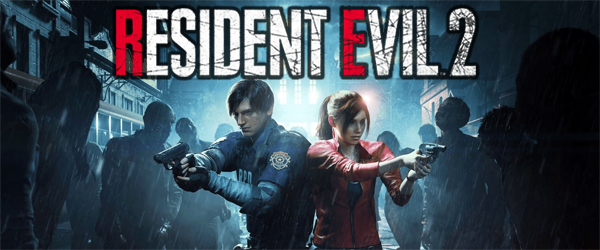
Getting started with this game was rough. First of all, streaming the game initially seemed to be blocked by Capcom, which sent me down an internet rabbit hole of trying to find a work-around. If I couldn't stream or capture gameplay, then it would be awfully hard for me to get decent screenshots -- let alone any video for possible YouTube content. I even Tweeted @AskPlaystation whether I could get a refund, so that I could instead purchase the game on Steam (where I knew I'd be able to record footage). @AskPlaystation never responded.
It was moot anyway, since the next day, I found that the problem was only associated with having High Dynamic Range (HDR) enabled in the PS4's settings. After disabling HDR, I was able to stream the game and capture video footage as normal. Of course, the game's colors didn't look so good -- but whatever, I could live with it. I guess this is a glitch. Maybe Capcom will fix the HDR streaming issue at some point in the future? I can't imagine that they deliberately disabled streaming with HDR, but left it enabled when HDR isn't being used.
You'll need to disable High Dynamic Range (HDR) on the PS4 if you want to stream REmake 2.
But even when I got the streaming and capture functionality working, I lost another night having to troubleshoot my PS4's network connectivity. I kept getting a DNS error. My PS4 has had internet connectivity issues off and on for years, so it might just have a bad network card. Or maybe my ISP is throttling it? It's hard to tell. The console regularly connects to the router and obtains an IP, but then fails to connect to the internet. Or it can connect to the internet, but fails to connect to PSN.
After several hours of troubleshooting, I had to manually enter the DNS addresses of my router's second and third DNS as the PS4's primary and secondary DNS, then sign out of the PSN, then boot up the PS4 in safe mode, then run a database rebuild (which took a few minutes), then reconnect to the PSN. That seems to have worked ... for now. We'll see how long the fix lasts...
In any case, these streaming and network issues cost me the first full weekend with the game. I'd have to play it on weeknights after work instead. Hopefully the game's quality would make up for these early frustrations...
I have adapted much of this review into a video critique on YouTube, if you'd prefer to watch a video.
The failure of REmake2's "hardcore" save system
Years ago, in the early years of this blog, I wrote an opinion piece called "The Genius of Resident Evil's classic save system". In that blog post, I wrote about how the way in which classic survival horror games (and Resident Evil in particular) limited the player's ability to save actually helped to amplify the horror atmosphere, while simultaneously facilitating open-ended exploration and creating the genre's trademark resource-management gameplay. I love the old Ink Ribbon method of saving, and I was thrilled that the brilliant REmake maintained these old systems to excellent effect. Other games like RE7 and Alien: Isolation also brought back more traditional survival horror save systems, but without the added complexity tying it to a consumable item (at least not by default).
Unfortunately, REmake 2's save system doesn't fare so well. By default, the game apparently uses autosaves and checkpoints, and you can manually save at typewriters without an Ink Ribbon. It all works similar to RE7. However, you can play on "hardcore" mode (which is available by default) to get an experience more similar to the original save system. Except, it doesn't work as well. In fact, it seems to be fundamentally broken.
It would be nice if the game would use Ink Ribbons from the item box,
rather than having to put it in your inventory, then put it back in the item box after you save.
Part of the reason for this is that the "hardcore" mode also doubles as the game's "hard" difficulty. On the "hardcore" mode, there are no autosaves or checkpoints, and you must consume an Ink Ribbon to save at the typewriters (just as in the original release). However, enemies also have more health and deal more damage, and resources are more scarce (Ink Ribbons apparently replace ammo pickups in certain places). This screws with the balance of the game such that the manual save system becomes less viable for a first-time playthrough.
... [More]
b46ccf26-8b91-4d4c-8bea-6508764790d3|9|2.6
Tags:PC, Leon Kennedy, Resident Evil, Resident Evil 2, Claire Redfield, zombie, remake, fallacy of sunk cost, Resident Evil 4, autosave, Capcom, Sony, save system, PlayStation 4, ink ribbon, Steam, typewriter, PC, Mr. X, Leon Kennedy, Tyrant, Claire Redfield, YouTube, zombie, fallacy of sunk cost, autosave, save system, ink ribbon, typewriter, Mr. X, Tyrant, YouTube

Capcom's remake of Resident Evil 2 is a pretty difficult game. Much of its design is based on classic survival horror paradigms, which many players may not be familiar with. Classic survival horror has been essentially dead since the release of Resident Evil 4 all the way back in 2005. (And if you want to know what I think of Resident Evil 4, you can listen to my commentary in a playthrough for On the Branch's Let's Play channel). Since then, every mainstream horror game has either followed a formula similar to RE4 (such as Dead Space and The Evil Within), or it has gone the Amnesia route and been about running and hiding from foes rather than confronting them (such as Outlast and Silent Hill: Shattered Memories).
If you didn't play Resident Evil 7 or the REmake of the first Resident Evil, then you probably haven't played a true survival horror game in over 10 years (if ever).
Even though it has an over-the-back, third-person camera, Resident Evil 2's remake firmly follows most of the design conventions of the classic (pre-Resident Evil 4) survival horror genre -- minus the tank controls. Here's some observations of mine that I hope will help you survive Raccoon City, whether you're an experienced survival horror gamer (like me) or a newbie.
[More]
dcefce99-43a9-4bf6-9399-66270df27952|0|.0
Tags:Resident Evil 2, remake, survival horror, zombie, ammunition, headshot, herb, boss, map, window, save game, Ink Ribbon, inventory, On the Branch
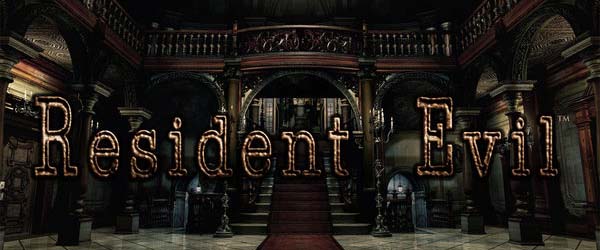
Not having a GameCube meant that I unfortunately missed out on some pretty high-quality games. Probably the most notable ones were Eternal Darkness and the remake of Resident Evil, neither of which, by itself, was enough to sell me on a console. I've since been able to play through a friend's copy of Eternal Darkness, and I had started on Resident Evil, but never got around to finishing it. When the HD remaster showed up on PSN, I was hesitant to buy it, since I knew that I could just play it on my friend's GameCube eventually.
Best of both worlds at the tip of your thumb
However, something in the previews really intrigued me. And that was the compromise that Capcom found for the never-ending conflict between the tank-style controls of the original PSX game and the analog control of newer games. Since I grew up with Resident Evil, Silent Hill, and other survival horror and similar adventure games, I've never had a problem with tank controls. They tend to be the lesser evil when dealing with static camera angles that change unpredictably (as in Resident Evil), and they are perfectly serviceable for behind-the-back or overhead cameras (as in the outdoor areas of Silent Hill). This ensures that the controls remain consistent during camera angle changes, since they are always relevant to the character rather than the camera.
But apparently, some people hate that control paradigm. They criticize it for making the characters feel too slow and lumbering, and that it lacks precision. The controls have oft been cited as one of the reasons for Resident Evil's declining popularity after Resident Evil 2, and supposedly ditching them was a major factor in the "renaissance" that was [supposedly] Resident Evil 4. But let me remind you that Resident Evil 4 had the exact same controls, and the character was just as slow and lumbering (if not moreso). The only difference was that the camera was moved to behind-the-back, and the gameplay switched to an action shooter rather than a more adventure-puzzle kind of game. So really, your problem was never with the controls...
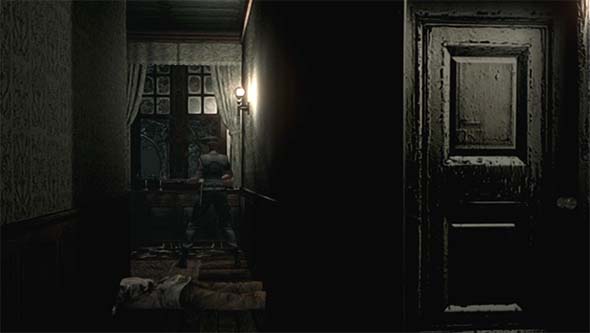
The original Resident Evil was criticized for how its controls and camera lead to frequent blind corners,
wasted ammunition, and cheap kills. The critics were right, but it wasn't game-breaking...
Regardless, analog control has its own baggage train of problems. Pressing the stick in one direction can cause the character to make sudden changes of direction if the camera suddenly changes. This can be mostly avoided by locking the character's movement as long as the player doesn't release or rotate the stick - and the HD Remaster does implement this. But this still leads to sudden turn-arounds when the player needs to move the character around a corner, since you sometimes have to move the stick to the exact opposite direction that you were pressing. And in cases in which the camera angle changes at the point where a change of direction is required to go around a corner or navigate an obstacle (which happens often), then the character can easily get lost in a cycle of spinning around between the two camera zones.
So there is no perfect solution to the problem of static cameras, but I tend to prefer the tank method due to its guarantee of consistency - even at the cost of some slow turning speeds. In any case, advocates of either paradigm should find exactly what they want in this remaster, since both configurations are implemented in the remastered game's default control scheme! Capcom's clever (and elegant) solution was to simply map the tank controls to the directional pad, while leaving the free analog movement on the analog stick. Players are, thus, free to alternate between whichever control they prefer without even having to go into a menu to change it. You can even alternate between them, on the fly, in the heat of the action if the situation warrants it, because I can definitely see how the analog movement could work well in some of the [rare] larger, open areas of the map (particularly for boss fights).
It's OK to hate these red-headed step-zombies
Most of the changes introduced in the GameCube remake serve to add further challenge. The most prominent display of this is the new "Crimson Head" zombie mechanic. If you kill a zombie and didn't manage to get lucky enough to blow its head off, you must burn its body in order to prevent it from resurrecting later in the game as a more dangerous "Crimson Head". These red-headed zombies are faster and more damaging than their precursor form. They can rapidly run across a room and grab you before you even realize they are there. They are also very well-tutorialized, since most players will probably encounter their first Crimson Head while attempting to retrieve the Armor Key from the hallway trapped with suits of armor on rails. The previous hallway includes a dead body that (if you didn't go out of your way to burn previously) will resurrect at this time. This hall has a system of mirrors in place that allow a tremendous degree of visibility from virtually every camera angle, meaning that whichever door you enter from, you'll have an opportunity to see the Crimson Head coming after you. It's a frantic and frightening moment!
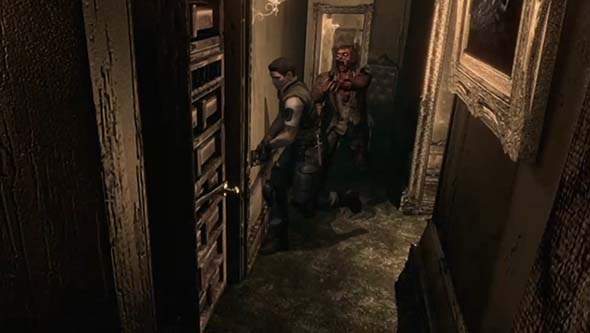
Bodies that you don't burn will resurrect as faster, more deadly "Crimson Heads"
that are difficult to avoid and require a second investment in resources to defeat.
Almost any zombie in the game can potentially turn into this more dangerous form. Destroying their head with a lucky shot or burning their bodies are the only ways to permanently ensure that they can't attack you... [More]
bedbfed9-e92f-45b6-b083-1b57db8977fc|1|5.0
Tags:Resident Evil, HD, remaster, remake, port, Capcom, survival horror, Jill Valentine, Chris Redfield, Albert Wesker, mansion, zombie, save, save system, tank controls, checkpoint, typewriter, ink ribbon, resource management, puzzle, logistics, GameCube, b-movie, Shinji Mikami

I've heard that a lot of players are complaining about the save system of Capcom's new Resident Evil 6. I haven't played the game yet because RE5 sucked, and the demo for RE6 sucked, so I can't comment on that game. What I can do, though, is take a moment to reflect on the genius of the classic Resident Evil save system.
Most of my readers know me as a Silent Hill fan [boy], so it's uncommon for me to heap praise upon Resident Evil. But I actually am a big fan of the original game (it was one of my favorite PlayStation games). Maybe some day, I'll get around to writing about how Resident Evil 4 killed my interest in the franchise...
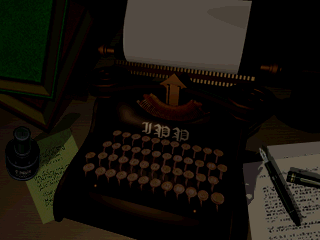
Would you like to save your progress?
[YES] NO
Resident Evil took a unique path in terms of it's save-game system. I'm not sure if it was the first to use this particular style of system, but it was definitely one of the best implementations that I played!
During the PSX era of the late 90's, game saves generally took one of 3 forms:
Resident Evil falls firmly in that last category, but with one significant (and game-changing) caveat: in addition to only being able to save at pre-defined locations, the ability to save was also tied to a consumable inventory item! [More]
11efae01-91a1-4c73-9ff1-8965e9a48534|9|4.2
Tags:Resident Evil, Resident Evil 5, Resident Evil 6, Shinji Mikami, save, save system, autosave, checkpoint, survival horror, resource management, typewriter, ink ribbon, Silent Hill, Amnesia: the Dark Descent
|

| 12 | | | | | | | 60 | | 11 | | | | | | | 55 | | 10 | | | | | | | 50 | | 09 | | | | | | | 45 | | 08 | | | | | | | 40 | | 07 | | | | | | | 35 | | 06 | | | | | | | 30 | | 05 | | | | | | | 25 | | 04 | | | | | | | 20 | | 03 | | | | | | | 15 | | 02 | | | | | | | 10 | | 01 | | | | | | | 05 |
|